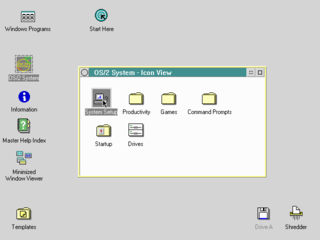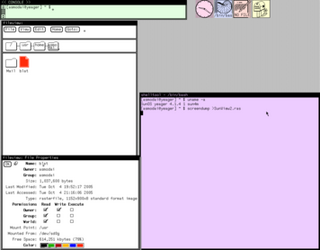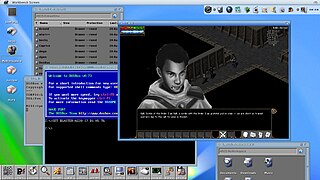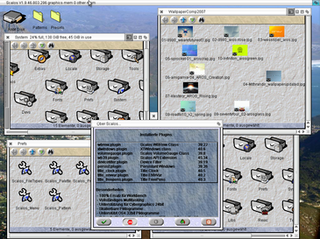Related Research Articles

A graphical user interface, or GUI, is a form of user interface that allows users to interact with electronic devices through graphical icons and visual indicators such as secondary notation. In many applications, GUIs are used instead of text-based UIs, which are based on typed command labels or text navigation. GUIs were introduced in reaction to the perceived steep learning curve of command-line interfaces (CLIs), which require commands to be typed on a computer keyboard.

The history of the graphical user interface, understood as the use of graphic icons and a pointing device to control a computer, covers a five-decade span of incremental refinements, built on some constant core principles. Several vendors have created their own windowing systems based on independent code, but with basic elements in common that define the WIMP "window, icon, menu and pointing device" paradigm.
In computing, a desktop environment (DE) is an implementation of the desktop metaphor made of a bundle of programs running on top of a computer operating system that share a common graphical user interface (GUI), sometimes described as a graphical shell. The desktop environment was seen mostly on personal computers until the rise of mobile computing. Desktop GUIs help the user to easily access and edit files, while they usually do not provide access to all of the features found in the underlying operating system. Instead, the traditional command-line interface (CLI) is still used when full control over the operating system is required.
MorphOS is an AmigaOS-like computer operating system (OS). It is a mixed proprietary and open source OS produced for the Pegasos PowerPC (PPC) processor based computer, PowerUP accelerator equipped Amiga computers, and a series of Freescale development boards that use the Genesi firmware, including the Efika and mobileGT. Since MorphOS 2.4, Apple's Mac mini G4 is supported as well, and with the release of MorphOS 2.5 and MorphOS 2.6 the eMac and Power Mac G4 models are respectively supported. The release of MorphOS 3.2 added limited support for Power Mac G5. The core, based on the Quark microkernel, is proprietary, although several libraries and other parts are open source, such as the Ambient desktop.
The taskbar is a graphical user interface element that has been part of Microsoft Windows since Windows 95, displaying and facilitating switching between running programs. The taskbar and the associated Start Menu were created and named in 1993 by Daniel Oran, a program manager at Microsoft who had previously collaborated on great ape language research with the behavioral psychologist B.F. Skinner at Harvard.

The Workplace Shell (WPS) is an object-oriented desktop shell produced by IBM's Boca Raton development lab for OS/2 2.0. It is based on Common User Access and made a radical shift away from the Program Manager type interface that earlier versions of OS/2 shared with Windows 3.x or the application-oriented WIMP interface of the Apple Macintosh. The Workplace Shell was also used in OS/2 Warp 3 and Warp 4, and the OS/2-based operating systems eComStation and ArcaOS.

The Magic User Interface is an object-oriented system by Stefan Stuntz to generate and maintain graphical user interfaces. With the aid of a preferences program, the user of an application has the ability to customize the system according to personal taste.

SunView is a discontinued user interface toolkit and windowing system from Sun Microsystems, launched in 1985, and included as part of its Unix implementation, starting with SunOS Release 3.0. Sun had introduced support in 1983 for a window-based environment known as the Sun Window System, providing the Sunwindows window manager and Suntools user interface toolkit.

A menu bar is a graphical control element which contains drop-down menus.
BOOPSI is an object-oriented programming system for AmigaOS. It extends the AmigaOS windowing environment (Intuition) with an object-oriented subsystem allowing a hierarchy of object classes in which every class defines a single GUI widget or interface event.

Workbench is the desktop environment and graphical file manager of AmigaOS developed by Commodore International for their Amiga line of computers. Workbench provides the user with a graphical interface to work with file systems and launch applications. It uses a workbench metaphor for representing file system organisation.
Intuition is the native windowing system and user interface (UI) engine of AmigaOS. It was developed almost entirely by RJ Mical. Intuition should not be confused with Workbench, the AmigaOS desktop environment and spatial file manager, which relies on Intuition for handling windows and input events. Workbench uses Intuition to produce displays and AmigaDOS to interact with filing system: AmigaDOS is built on Exec.

AROS Research Operating System is a free and open-source multi media centric implementation of the AmigaOS 3.1 application programming interface (API) which is designed to be portable and flexible. As of 2021, ports are available for personal computers (PCs) based on x86 and PowerPC, in native and hosted flavors, with other architectures in development. In a show of full circle development, AROS has been ported to the Motorola 68000 series (m68k) based Amiga 1200, and there is also an ARM port for the Raspberry Pi series.
ReAction GUI is the widget toolkit engine that is used in AmigaOS 3.2–4.1.
Hunk is the executable file format of tools and programs of the Amiga Operating System based on Motorola 68000 CPU and other processors of the same family. The file format was originally defined by MetaComCo. as part of TRIPOS, which formed the basis for AmigaDOS. This kind of executable got its name from the fact that the software programmed on Amiga is divided in its internal structure into many pieces called hunks, in which every portion could contain either code or data.

AmigaOS is a family of proprietary native operating systems of the Amiga and AmigaOne personal computers. It was developed first by Commodore International and introduced with the launch of the first Amiga, the Amiga 1000, in 1985. Early versions of AmigaOS required the Motorola 68000 series of 16-bit and 32-bit microprocessors. Later versions were developed by Haage & Partner and then Hyperion Entertainment. A PowerPC microprocessor is required for the most recent release, AmigaOS 4.

Origyn Web Browser (OWB) is a discontinued web browser that was synchronized with WebKit and sponsored by the technology company Pleyo. OWB provides a meta-port to an abstract platform with the aim of making porting to embedded or lightweight systems faster and easier. This port is used for embedded devices such as set-top boxes, and other consumer electronics.

Scalos is a desktop replacement for the original Amiga Workbench GUI, based on a subset of APIs and its own front-end window manager of the same name. Scalos is NOT an AmigaOS replacement, although its name suggests otherwise. Its goal is to emulate the real Workbench behaviour, plus integrating additional functionality and an enhanced look. As stated on its website, the name "Scalos" was inspired by the fictional time-accelerated planet Scalos in the Star Trek episode "Wink of an Eye".

Hollywood is a commercially distributed programming language developed by Andreas Falkenhahn which mainly focuses on the creation of multimedia-oriented applications. Hollywood is available for AmigaOS, MorphOS, WarpOS, AROS, Windows, macOS, Linux, Android, and iOS. Hollywood has an inbuilt cross compiler that can automatically save executables for all platforms supported by the software. The generated executables are completely stand-alone and do not have any external dependencies, so they can also be started from a USB flash drive. An optional add-on also allows users to compile projects into APK files.
References
- ↑ Thom Holwerda. "AROS Gets Themeing Support, USB Keyboard Driver". OSNews. Archived from the original on 3 March 2016. Retrieved 2007-04-06.
"Wanderer is the whole desktop, not just a filemanager".
- ↑ Giancarlo "shinkuro" Gignina. "primo contatto con AROS". Giancarlo Gignina (in Italian Language).